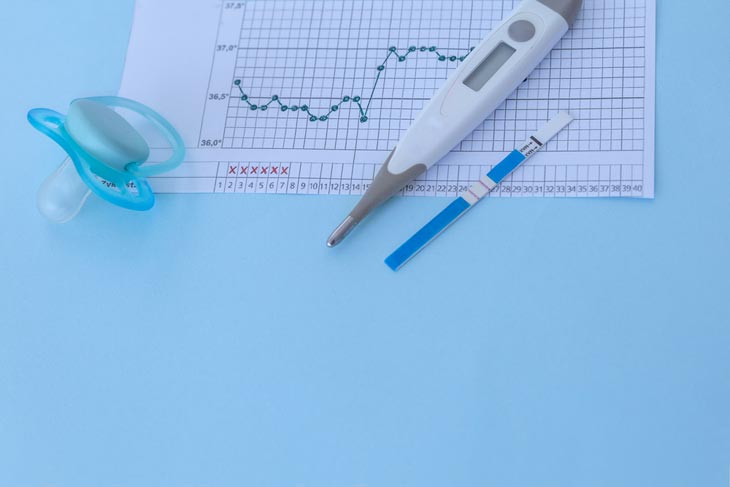Women can determine their ovulation cycle in many ways, typically body temperature readings.
2-3 days before the increase in temperature is the most potential for conception. However, you surprisingly notice no temp rise after ovulation but pregnant.
This puts you off because you probably may experience an unplanned pregnancy. Should you completely believe the rise in temperature after ovulation as a sign?
We provide you with other alternatives that you could take into consideration.
Basal Body Temperature And Ovulation – Does Temp Always Rise After Ovulation?

You had better know about the relationship between temperature and ovulation.
For those who have stable and healthy days of ovulation, the BBT is divided into 2 processes: low temperature and high-temperature levels, which are repeated constantly and periodically.
This change in BBT can somehow reflect your reproductive health.
When the menstrual cycle begins, the basal body temperature will usually drop for about 2 weeks, so-called the low-temperature period. When ovulation occurs, BBT tends to rise.
The phase when temp rises after ovulation will continue until the next menstrual cycle. Therefore, women often feel an increase in body temperature before menstruation.
If you feel the high temperature continues and lasts for more than 2 weeks, you are most likely pregnant.
By contrast, when your temperature remains unchanged or stays low during menstruation, you may not ovulate or have ovulation disorders.
The change in temperature at ovulation results from the level of progesterone hormone.
During ovulation, the hormone progesterone increases, causing the body temperature to rise.
Then, just before the next menstrual period begins, progesterone levels drop, leading to a decrease in BBT.
This concept cannot be applied to pregnant women because progesterone hormone levels constantly remain high.
BBT is decisive for your morning body temperature. For this method, women need to measure BBT every morning after waking up regularly.
Any diet, the daily activity, or any instability of your physiological elements also affects your BBT. That’s why body temp does not always rise after ovulation.
Since the body temperature shows a slight increase – 0.3-0.5 degrees Celsius, the feeling of BBT change tends not to be so obvious.
According to many surveys, only about 10% of women experience a clear temperature rise within one day of the ovulatory cycle. But what if you are experiencing no BBT rise but pregnant?
No Temp Rise After Ovulation But pregnant – Is It Possible?
Can you be pregnant without a rise in BBT? The answer is Yes. BBT not rising after ovulation can not seize any chance for you to get pregnant.
This reading is not that accurate due to some factors, such as the time you wake up in the morning.
In a popular belief, the soonest sign of pregnancy is that your body temperature may be higher over 16 days.
You need to record your BBT every day and keep track of your own temperature chart.
You can draw your own BBT graph, but it is quite time-consuming and not very precise. Instead, you can use the ovulation calculator application installed on the phone.
To get the most spot-on temperature readings, you need to measure it every morning (after 6 hours of sleep at least) when you have not done any action yet (sitting up, walking, personal hygiene, or even shaking the thermometer).
Measurement times on each day should be fixed, or not more than 30 minutes apart.
Monitor throughout the process and notice that your core body temperature stays above normal temperatures for about 10 days? It is a sign that you are getting pregnant.
However, the basal body temperature method is not claimed to be absolutely correct.
The temperature rise and fall do not take place according to a fixed cycle. It fluctuates depending on the mode of living and the natural body of each woman.
As you know, temperature readings require high meticulousness.
A small wrong movement can lead to false readings of core body temperature. In our opinion, you may face one of the following two cases.
The first one is that you have imprecisely measured and recorded your body temperature in the tracking process.
For example, you had a poor sleep, drank alcohol the night before, or accidentally went to the bathroom before taking a measurement.
Using a digital thermometer instead of mercury can also be an answer for the temperature deviations. Your mistakes mislead you that your body temperature does not rise.
In the other case, your body inherently maintains a stable temperature.
And we would like to emphasize that the 0.3-0.5 temperature difference is not an alarming issue regarding pregnancy.
We highly suggest using basal body temperature tracking only to determine ovulating phase rather than to diagnose pregnancy.
Why Is BBT Not Completely Reliable For Ovulation Check?
Complicated measurements, slight and unobvious temperature deviations, and unfixed signs are the three largest reasons that make the basal body temperature method unreliable.
Besides basal body temperature measurement, you can look for other ways to track the ovulation phase or plan for pregnancy more accurately.
Cervical mucus can be a wise alternative, which is considered one of the clearest and most certain signs.
Before the time of ovulation, the hormone estrogen increases cervical fluid and transforms it into a viscous solution.
After days of ovulation, the hormone progesterone causes the cervical fluid to become thick and sticky, protecting the vagina from foreign invaders.
Your body temperature can confirm that ovulation has already occurred.
Meanwhile, cervical mucus can sign when a woman is about to ovulate, and they can use that information to calculate the time to have sex.
Nowadays, a more modern method can also be applied: ovulation test strips.
This approach can detect the amount of luteinizing hormone in the urine. The level of this hormone usually increases 2-4 times during ovulation.
This effective method can also be used by women experiencing irregular periods. A 1-line stick means that ovulation has not yet begun.
2 lines signal that ovulation is near. Especially if the second line is darker, ovulation will occur in the next 24-48 hours.
Conclusion

In sum, no temp rise after ovulation but pregnant can come as a surprise for some women.
That’s why you should combine other ovulation phase calculations instead of focusing only on core body temperature.
Besides, you should not worry too much about changes in basal body temperature unless there is a large fluctuation.
If you find that your body temperature rises/falls a lot or the cervical fluid turns dark brown, you can contact your doctor for specific advice about reproductive health.
Most importantly, let’s maintain an optimistic mind and a healthy lifestyle.
